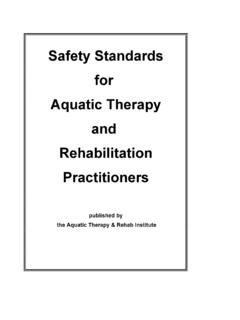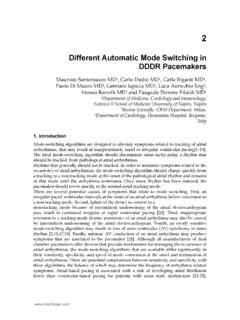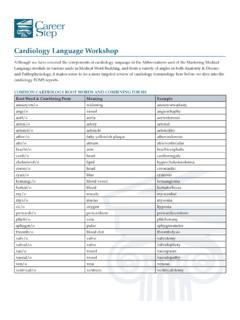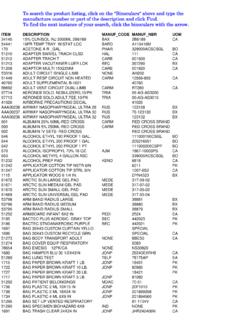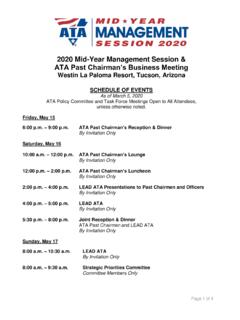Transcription of Aquatic Therapy Temperatures
1 Aquatic Therapy TemperaturesImagine yourself walking to an 82 pool. Whathas happened to your skin, your shoulders, yourmuscles; and what has happened to the bodysystems that you aren t even aware of?Now imagine yourself walking into a 92 has happened to your skin, your shoulders,your muscles; and what has happened to thebody systems that you aren t even aware of?Pool temperature makes a difference in how youfeel, how your clients feel and what type oftherapeutic exercise you ll use. Remember thisconcept:There are two ways to increase body heat:Internally and externally. If your water is warm(94 98 ) your program should be passive(because you re heating externally) and if youwater is moderate (86 90 ) your program canbe more active (to create heat internally). Thisworks unless you re working with clients whohave thermoregulatory bariatric client, prenatal women, clients withMS, clients with cardiac issues, and childrencould overheat.
2 Their programs should bepassive in thermoneutral (92 ) or warm with rheumatalogical issues, painmanagement clients, and some pediatric clientscould become chilled and experience anexacerbation of tone, pain or joint issues. Inmoderate or cool water their programs should bemore what s the right temperature for a therapeuticpool? Monica Lepore, in her book on AdaptedAquatics, says, These pools are normally keptbetween 84 and 94 degrees, which is higher thanmultipurpose pools. Bruce Becker (MD) andAndrew Cole after reviewing research state that, Most studies that demonstrated positive effectscontrolled water temperature in the range of 26-30 C (average = C). Therapeutic poolsthat tend to have higher Temperatures may bemore effective for rehabilitation application, butthere are few temperature-controlled studiesdealing with patient populations.
3 Theyconclude that Aquatic exercise can beperformed in a wide range of Temperatures , butwarmer Temperatures appear to be morefavorable for nonswimming activity. Another author, Glenda Baum from the UK, getsinto the temperature concept more thoroughly. Heat is lost from the body much faster in water(a denser medium) than when exercisingelsewhere, even though the ambient temperaturein a gym or studio is likely to be much less thanthe water temperature. Thin people lose heatmore quickly because they do not have such agood layer of subcutaneous fat. On the otherhand, obese people have too much insulation,and could theoretically be at risk fromoverheating. A characteristic of many conditions is that painis made worse when cold, and reduced whenwarm. Generally speaking, people with jointdisease far prefer the warmer temperature of athermoneutral hydrotherapy pool, although theexcessive temperature of some hydrotherapypools ( above 34 C) whilst being pleasant forthe arthritic joints, can be debilitating.
4 An idealtemperature for exercising with chronic arthritiswould be thermoneutral. Whereas in the UK, itis not recommended that therapeutic activitytakes place if the water is less than 27 C, in theUnited States, pool water is generally kept lowerthan that, at about 24 C. A warm pool causesvasodilation, which places an additional demandon the heart as blood is not then being shuntedaway from the skin to be diverted to thedemanding working muscles. A very cold poolmight cause vasoconstriction with anaccompanying increase in blood comments, however, relate to extremes intemperature, above 30 C and below 20 C. Bates and Hanson s book makes it easy with, The temperature of a therapeutic pool is 92 to98 F (33 - 37 C). This temperature is notsuitable for aerobic conditioning.
5 Thetemperature of a swimming pool is usuallybetween 80 and 85 F (27 - 30 C). Another source, Aquatic Therapy Programmingby Koury states, During early pool therapywhen clients are minimally active, watertemperature can significantly affect thephysiological and, more importantly, thepsychological success of the Aquatic therapysession. A critical temperature range for manypeople is 89 to 90 F. Margaret Campion searched the research andfound extensive information: Under normalcircumstances the heat regulating mechanismsmaintain the body temperature within narrowlimits. In comfortable surroundings the skintemperature of the head and torso is C(92 F) which according to Finnerty and Corbitt(1960) is the point of thermal indifference of theskin for water.
6 On exposure to a hotenvironment subcutaneous Temperatures risemost rapidly in the peripheral parts of the bodyso that the difference in temperature between thetorso and the extremities is obliterated. In warmwater, heat loss is limited so a systemic rise intemperature occurs Huddleston (1961) believed a pool temperatureof to (87 to 92 F) was ideal fortherapeutic exercise and general physicalprogrammes providing both sedative andstimulating effects The work of Finnerty and Corbitt (1960) showsthat C (92 F) is neutral and has a sedativeeffect. Temperatures just above this are warmyet still produce sedation, but when the heatrises above C (96 F) and upwards theeffects are stimulating and temperature is intothe hot range. These authors propose C (84 F) is tepid and that below C(80 F) produces stimulating working with ante- and postnatal womenin water exercise programmes Vleminckx (1988)advocates a temperature range between 30 and32 C (86 and F).
7 The advantage of thisrange especially at the highest point is that itallows for relaxation and permits activities totake place at a more leisurely pace. When thewater is cooler it is important that exercise iscarried out at a faster work of Franchimone (1983) stressesthat Temperatures above 35 C (95 F) aredisadvantageous as the beneficial effects oftreatment in warm water are dissipated due toalterations in the cardiovascular system whichmay produce untoward consequences. Highertemperatures do produce relaxation but whenpatients are subjected to more than 15-20 min inwater heated to 35 C (95 ) or above they becomeenervated, tired and frequently sleep for up tothree hours following treatment. Koga (1985)found that a neutral water temperature for lightexercise was 31 C ( F) and that lightexercise in Temperatures of 27 C ( F), 31 C( F) and 35 C (95 F) showed nodiscrepancies as far as the thermal response ofthe body was hydrotherapy pools where a variety ofconditions and age groups are treated it isimpossible to suit everyone.
8 Whitelock andBarefoot (1993) advocate a thermo-neutralwater temperature of 35 C and a temperaturerange of 32 to 37 , in this author s experience the poolwater should be heated to a range between 32 C( F) and 34 C ( F) or 35 C (95 F) butno higher. This caters for all conditions andavoids any debilitating or untoward effectsprovided that all contra-indications tohydrotherapy have been considered. In the past,and in many pools even today, the trend ofkeeping the water temperature in the higherranges goes against research findings, ignoresthe thermal indifference of the skin temperatureand puts patients and physiotherapists at s the scoop in books on Aquatic Therapy . Sowhat s best? A pool temperature of 92 seemsideal for most clients. Therapy , however, isbeing done in 82 to 98 pools.
9 Remember thatyou ll use a more passive technique (Watsu, AiChi) at higher Temperatures and more activetechniques (Burdenko, Halliwick) at lowertemperatures. And finally, there are sometemperatures that just won t work for , A and Hanson, N. Aquatic Exercise Therapy . W. B. Saunders. Philadelphia PA, , G. Aquarobics - The Training Manual. W. B. Saunders. Philadelphia PA, , B. and Cole, A. Comprehensive Aquatic Therapy . Butterworth Heinemann. Woburn MA, , R. and G. Rapp. Problems of Body Heat Loss in Water Immersion .Aerospace Medicine,1970, 41, , M. Hydrotherapy - Principles and Practice. Butterworth Heinemann. Woburn MA, 1998. Cool in the Pool, Idea Today(September, 1988), p. , D. Energy Requirements During Exercise in the Water. Journal of Sports Medicine and Physical Fitness,1971, pp.
10 11, , D. Effects of Water Temperature on Aerobic Working Capacity. Research Quarterly,(1978) 39:1, , W. Larry. Considerations for Preventive and Rehabilitative Exercise Programs during Periods of HighHeat and Humidity, The Exercise Standards and Malpractice Reporter,Vol. 3, No. 1 (January, 1989) p. , J. Aquatic Therapy Programming Guidelines for Orthopedic Rehabilitation. Human Kinetics. ChampaignIL, , Len, PhD and Jerry J. Mayo, The Physiological Effects of Aquatic Exercise: A Brief Review, (August 1997)Lepore, M. Adapted Aquatics Programming - A Professional Guide. Human Kinetics. Champaign IL, , Jerry. Retreat from the Heat, AmericanFitness Quarterly(October, 1989) pp. , R. Aquatic Rehabilitation. Lippincott. Philadelphia PA, , Mary E. The Big Chill Is No Thrill, The AKWA Letter,Vol. 4, No. 3. (September, 1990) p. , Ruth. AQUATICS - The Complete Reference Guide for Aquatic Fitness Professionals.


